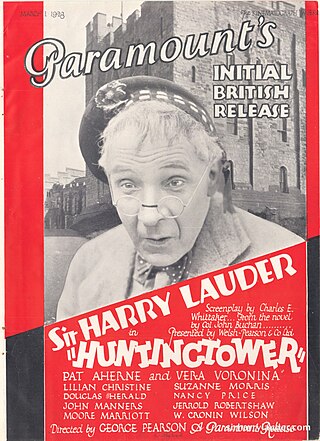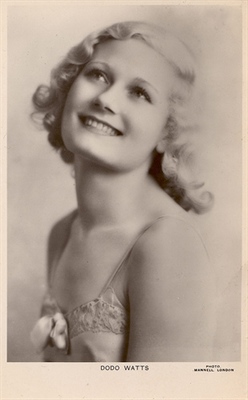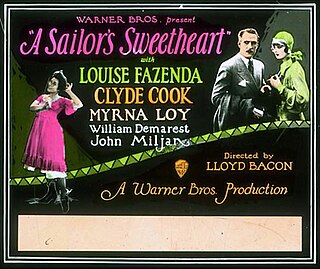
Sir Henry Lauder was a Scottish singer and comedian popular in both music hall and vaudeville theatre traditions; he achieved international success.

"Auld Lang Syne" is a popular Scottish song, particularly in the English-speaking world. Traditionally, it is sung to bid farewell to the old year at the stroke of midnight on New Year's Eve/Hogmanay. By extension, it is also often heard at funerals, graduations, and as a farewell or ending to other occasions; for instance, many branches of the Scouting movement use it to close jamborees and other functions.

William Brian de Lacy Aherne was an English actor of stage, screen, radio and television, who enjoyed a long and varied career in Britain and the United States.

Hugh E. Wright was a French-born, British actor and screenwriter. He was the father of actor Tony Wright.
Dorothy Boyd was an English film actress. She appeared in more than 30 films between 1926 and 1940. She was born in Sanderstead, Surrey, England and died in England. Without any previous stage experience, she came to films when she appeared in three short films made in the Phonofilm sound-on-film process, Knee Deep in Daisies (1926), The Sentence of Death (1927), and The Burglar and the Girl (1928). A director was impressed by her and brought her to the notice of Alfred Hitchcock who cast her in his feature Easy Virtue (1928).

Kid Boots is a musical with a book by William Anthony McGuire and Otto Harbach, music by Harry Tierney, and lyrics by Joseph McCarthy. The show was staged by Edward Royce.

Underground is a 1928 British sound drama film directed by Anthony Asquith and starring Brian Aherne, Elissa Landi, Cyril McLaglen, and Norah Baring. While the film has no audible dialogue, it was released with a synchronized musical score with sound effects using both the sound-on-disc and sound-on-film process. The film examines the lives of ordinary Londoners and the romance between them, set on and around the London Underground.
"Auld Lang Syne" is a poem by Robert Burns and set to the tune of a traditional folk song.

Patrick de Lacy Aherne was an English film actor. He was the son of the architect William de Lacy Aherne, and the elder brother of the actor Brian Aherne. The family lived at Kings Norton.

Huntingtower is a 1928 British silent adventure film, made at Cricklewood Studios. It was directed by George Pearson and starred Harry Lauder, Vera Voronina and Patrick Aherne. It was based on the 1922 novel Huntingtower by John Buchan. The film was fairly successful on its release.

Dorothy Margaret Watts (1910–1990), known professionally as Dodo Watts, was a British stage and film actress. She played Fay Eaton in the 1929 Broadway version of Ian Hay's play The Middle Watch, and reprised her role in the 1930 British film version the following year. When her career wound down, she became a business woman, owning a successful millinery firm in London's West End. She was later a casting director, and head of casting for ABC Weekend TV ; and largely responsible for casting Diana Rigg in the role of Emma Peel in The Avengers TV series. She later became a theatrical agent.

City of Play is a 1929 British part-talkie sound drama film directed by Denison Clift and starring Chili Bouchier, Patrick Aherne and Lawson Butt. It was made by Gainsborough Pictures and produced by Michael Balcon. The film featured a few sequences with dialogue and singing while the remaining film used English intertitles along with a musical score and sound effects.

A Sailor's Sweetheart is a 1927 Warner Bros. synchronized sound film comedy directed by Lloyd Bacon. While the film has no audible dialog, it was released with a synchronized musical score with sound effects using the Vitaphone sound-on-disc process. It stars Louise Fazenda and Clyde Cook.
The Broken Melody is a sound 1929 British romance film directed by Fred Paul and starring Georges Galli, Andrée Sacré and Enid Stamp-Taylor. While the film has no audible dialog, it features a synchronized musical score, singing and sound effects on the soundtrack. The film was shot at Cricklewood Studios and distributed by Paramount Pictures. It was based on a play by Herbert Keith and James Leader. An exiled Prince living in Paris, begins a daliance with an opera singer before returning to his wife.
Love's Option is a 1928 British silent adventure film directed by George Pearson and starring Dorothy Boyd, Patrick Aherne and James Carew. It was made at Cricklewood Studios based on the novel The Riddle by Douglas Newton. The film was distributed by Paramount Pictures' British subsidiary, enabling the company to meet its yearly quota set down by the British government. The film follows several rivals attempting to gain control of a valuable Spanish copper mine. It was known by the alternative title A Girl of Today.
Auld Lang Syne is a 1917 British silent crime film directed by Sidney Morgan and starring Violet Graham, Henry Baynton and Sydney Fairbrother. The film is notable for marking the screen debut of Jack Buchanan, who went on to be a leading star. It was produced in a film studio at Ebury Street in Westminster.
Violet Graham was an English stage and film actress. Graham played leading roles in several films of the silent era, often appearing in those of the director Sidney Morgan such as Auld Lang Syne. Graham was in the original cast of the 1909 musical The Arcadians.
Auld Lang Syne is a 1937 British historical drama film directed by James A. FitzPatrick and starring Andrew Cruickshank, Christine Adrian and Marian Spencer. It portrays the life of the eighteenth century Scottish poet Robert Burns. The film was a quota quickie, produced at Shepperton Studios for distribution by MGM. Quota costume films were rare, as the costs generally exceeded the limited budgets allowed for productions.
This is a summary of 1929 in music in the United Kingdom.

Blinkeyes is a 1926 British silent drama film directed by George Pearson and starring Betty Balfour, Tom Douglas, and Frank Stanmore.












